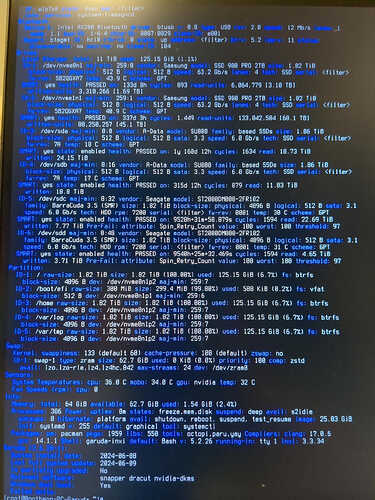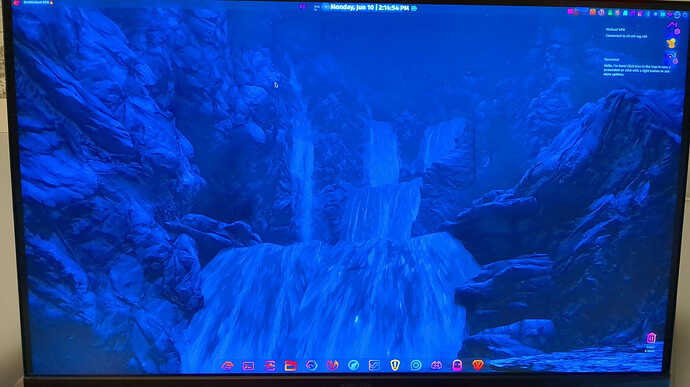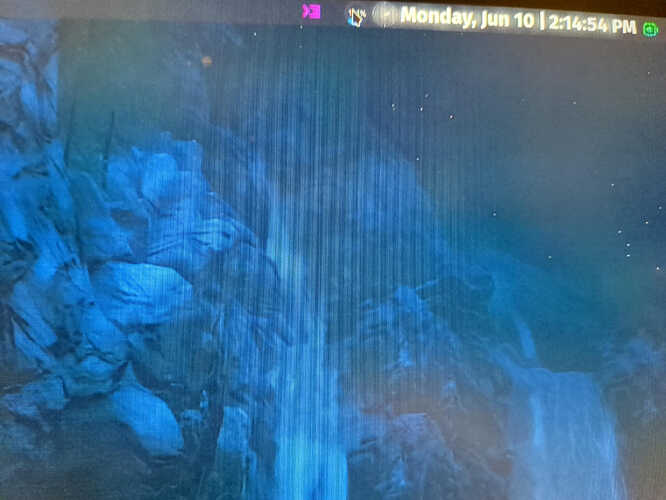Went into recovery mode to get the Garuda-inxi but I can’t scroll up to see the entire thing (Not like I can copy paste it anyway) so I’ve done my best to include what I can that shows.
Basically I added CPU/core metric to the top bar of the KDE dragonized theme and now nothing moves on the desktop. Can’t interact with anything. Can’t seem to do anything except CTRL+ALT+DEL. Restarting does nothing (problem persists), logging out also does nothing. Wayland also suffers from the same issue (arguable worse. Don’t even know how they both transferred together)
Garuda-inxi best do
Just frozen on the desktop like this
Edit: It appears the virtual desktop manager is still working so I can search things and open the konsole as while as browsers etc… just not interact with the desktop
Complete garuda.inxi
System:
Kernel: 6.9.3-zen1-1-zen arch: x86_64 bits: 64 compiler: gcc v: 14.1.1
clocksource: tsc avail: hpet,acpi_pm
parameters: BOOT_IMAGE=/@/boot/vmlinuz-linux-zen
root=UUID=4b50f2bb-29e3-46db-902d-6f9025f83b73 rw rootflags=subvol=@
quiet loglevel=3 ibt=off
Desktop: KDE Plasma v: 6.0.5 tk: Qt v: N/A info: frameworks v: 6.2.0
wm: kwin_wayland vt: 1 dm: SDDM Distro: Garuda base: Arch Linux
Machine:
Type: Desktop System: ASUS product: N/A v: N/A serial: <superuser required>
Mobo: ASUSTeK model: ROG CROSSHAIR VIII DARK HERO v: Rev X.0x
serial: <superuser required> part-nu: SKU uuid: <superuser required>
UEFI: American Megatrends v: 4702 date: 10/20/2023
Battery:
Device-1: hidpp_battery_0 model: Logitech MX Vertical Advanced Ergonomic
Mouse serial: <filter> charge: 55% (should be ignored) rechargeable: yes
status: discharging
CPU:
Info: model: AMD Ryzen 9 5900X bits: 64 type: MT MCP arch: Zen 3+ gen: 4
level: v3 note: check built: 2022 process: TSMC n6 (7nm) family: 0x19 (25)
model-id: 0x21 (33) stepping: 0 microcode: 0xA20102B
Topology: cpus: 1x cores: 12 tpc: 2 threads: 24 smt: enabled cache:
L1: 768 KiB desc: d-12x32 KiB; i-12x32 KiB L2: 6 MiB desc: 12x512 KiB
L3: 64 MiB desc: 2x32 MiB
Speed (MHz): avg: 3788 high: 4755 min/max: 2200/4950 boost: enabled
scaling: driver: acpi-cpufreq governor: performance cores: 1: 4755 2: 3700
3: 3700 4: 3700 5: 3700 6: 3700 7: 3700 8: 3700 9: 3700 10: 3600 11: 3700
12: 3599 13: 4750 14: 3700 15: 3700 16: 3700 17: 3799 18: 3814 19: 3700
20: 3700 21: 3700 22: 3700 23: 3700 24: 3700 bogomips: 177608
Flags: avx avx2 ht lm nx pae sse sse2 sse3 sse4_1 sse4_2 sse4a ssse3 svm
Vulnerabilities: <filter>
Graphics:
Device-1: NVIDIA AD102 [GeForce RTX 4090] vendor: Micro-Star MSI
driver: nvidia v: 550.78 alternate: nouveau,nvidia_drm non-free: 550.xx+
status: current (as of 2024-04) arch: Lovelace code: AD1xx
process: TSMC n4 (5nm) built: 2022+ pcie: gen: 1 speed: 2.5 GT/s lanes: 16
link-max: gen: 4 speed: 16 GT/s ports: active: none off: DP-2
empty: DP-1,DP-3,HDMI-A-1 bus-ID: 0b:00.0 chip-ID: 10de:2684
class-ID: 0300
Display: wayland server: X.org v: 1.21.1.13 with: Xwayland v: 24.1.0
compositor: kwin_wayland driver: X: loaded: nvidia unloaded: modesetting
alternate: fbdev,nouveau,nv,vesa gpu: nvidia display-ID: 0
Monitor-1: DP-2 res: 2560x1440 size: N/A modes: N/A
API: EGL v: 1.5 hw: drv: nvidia platforms: device: 0 drv: nvidia device: 2
drv: swrast gbm: drv: nvidia surfaceless: drv: nvidia wayland: drv: nvidia
x11: drv: zink inactive: device-1
API: OpenGL v: 4.6.0 compat-v: 4.5 vendor: nvidia mesa v: 550.78
glx-v: 1.4 direct-render: yes renderer: NVIDIA GeForce RTX 4090/PCIe/SSE2
memory: 23.43 GiB display-ID: :1.0
API: Vulkan v: 1.3.279 layers: 11 device: 0 type: discrete-gpu
name: NVIDIA GeForce RTX 4090 driver: nvidia v: 550.78 device-ID: 10de:2684
surfaces: xcb,xlib,wayland
Audio:
Device-1: NVIDIA AD102 High Definition Audio vendor: Micro-Star MSI
driver: snd_hda_intel v: kernel pcie: gen: 4 speed: 16 GT/s lanes: 16
bus-ID: 0b:00.1 chip-ID: 10de:22ba class-ID: 0403
Device-2: AMD Starship/Matisse HD Audio vendor: ASUSTeK
driver: snd_hda_intel v: kernel pcie: gen: 4 speed: 16 GT/s lanes: 16
bus-ID: 0d:00.4 chip-ID: 1022:1487 class-ID: 0403
Device-3: Schiit Audio Modi 3+ driver: snd-usb-audio type: USB rev: 2.0
speed: 480 Mb/s lanes: 1 mode: 2.0 bus-ID: 3-2.4:4 chip-ID: 30be:1014
class-ID: 0102
API: ALSA v: k6.9.3-zen1-1-zen status: kernel-api with: aoss
type: oss-emulator tools: N/A
Server-1: PipeWire v: 1.0.7 status: active with: 1: pipewire-pulse
status: active 2: wireplumber status: active 3: pipewire-alsa type: plugin
4: pw-jack type: plugin tools: pactl,pw-cat,pw-cli,wpctl
Network:
Device-1: Realtek RTL8125 2.5GbE vendor: ASUSTeK driver: r8169 v: kernel
pcie: gen: 2 speed: 5 GT/s lanes: 1 port: e000 bus-ID: 05:00.0
chip-ID: 10ec:8125 class-ID: 0200
IF: enp5s0 state: up speed: 1000 Mbps duplex: full mac: <filter>
Device-2: Intel I211 Gigabit Network vendor: ASUSTeK driver: igb v: kernel
pcie: gen: 1 speed: 2.5 GT/s lanes: 1 port: d000 bus-ID: 06:00.0
chip-ID: 8086:1539 class-ID: 0200
IF: enp6s0 state: down mac: <filter>
Device-3: Intel Wi-Fi 6 AX200 driver: iwlwifi v: kernel pcie: gen: 2
speed: 5 GT/s lanes: 1 bus-ID: 07:00.0 chip-ID: 8086:2723 class-ID: 0280
IF: wlp7s0 state: down mac: <filter>
IF-ID-1: wg0-mullvad state: unknown speed: N/A duplex: N/A mac: N/A
Info: services: NetworkManager, smbd, systemd-timesyncd, wpa_supplicant
Bluetooth:
Device-1: Intel AX200 Bluetooth driver: btusb v: 0.8 type: USB rev: 2.0
speed: 12 Mb/s lanes: 1 mode: 1.1 bus-ID: 1-6:4 chip-ID: 8087:0029
class-ID: e001
Report: btmgmt ID: hci0 rfk-id: 0 state: up address: <filter> bt-v: 5.2
lmp-v: 11 status: discoverable: no pairing: no class-ID: 6c0104
Drives:
Local Storage: total: 11 TiB used: 125.24 GiB (1.1%)
SMART Message: Unable to run smartctl. Root privileges required.
ID-1: /dev/nvme0n1 maj-min: 259:0 vendor: Samsung model: SSD 980 PRO 2TB
size: 1.82 TiB block-size: physical: 512 B logical: 512 B speed: 63.2 Gb/s
lanes: 4 tech: SSD serial: <filter> fw-rev: 5B2QGXA7 temp: 45.9 C
scheme: GPT
ID-2: /dev/nvme1n1 maj-min: 259:1 vendor: Samsung model: SSD 980 PRO 2TB
size: 1.82 TiB block-size: physical: 512 B logical: 512 B speed: 63.2 Gb/s
lanes: 4 tech: SSD serial: <filter> fw-rev: 5B2QGXA7 temp: 39.9 C
scheme: GPT
ID-3: /dev/sda maj-min: 8:0 vendor: A-Data model: SU800 size: 1.86 TiB
block-size: physical: 512 B logical: 512 B speed: 6.0 Gb/s tech: SSD
serial: <filter> fw-rev: 7A scheme: GPT
ID-4: /dev/sdb maj-min: 8:16 vendor: A-Data model: SU800 size: 1.86 TiB
block-size: physical: 512 B logical: 512 B speed: 6.0 Gb/s tech: SSD
serial: <filter> fw-rev: 7A scheme: GPT
ID-5: /dev/sdc maj-min: 8:32 vendor: Seagate model: ST2000DM008-2FR102
size: 1.82 TiB block-size: physical: 4096 B logical: 512 B speed: 6.0 Gb/s
tech: HDD rpm: 7200 serial: <filter> fw-rev: 0001 scheme: GPT
ID-6: /dev/sdd maj-min: 8:48 vendor: Seagate model: ST2000DM008-2FR102
size: 1.82 TiB block-size: physical: 4096 B logical: 512 B speed: 6.0 Gb/s
tech: HDD rpm: 7200 serial: <filter> fw-rev: 0001 scheme: GPT
Partition:
ID-1: / raw-size: 1.82 TiB size: 1.82 TiB (100.00%) used: 125.24 GiB (6.7%)
fs: btrfs dev: /dev/nvme0n1p2 maj-min: 259:7
ID-2: /boot/efi raw-size: 300 MiB size: 299.4 MiB (99.80%)
used: 588 KiB (0.2%) fs: vfat dev: /dev/nvme0n1p1 maj-min: 259:6
ID-3: /home raw-size: 1.82 TiB size: 1.82 TiB (100.00%)
used: 125.24 GiB (6.7%) fs: btrfs dev: /dev/nvme0n1p2 maj-min: 259:7
ID-4: /var/log raw-size: 1.82 TiB size: 1.82 TiB (100.00%)
used: 125.24 GiB (6.7%) fs: btrfs dev: /dev/nvme0n1p2 maj-min: 259:7
ID-5: /var/tmp raw-size: 1.82 TiB size: 1.82 TiB (100.00%)
used: 125.24 GiB (6.7%) fs: btrfs dev: /dev/nvme0n1p2 maj-min: 259:7
Swap:
Kernel: swappiness: 133 (default 60) cache-pressure: 100 (default) zswap: no
ID-1: swap-1 type: zram size: 62.7 GiB used: 65.8 MiB (0.1%) priority: 100
comp: zstd avail: lzo,lzo-rle,lz4,lz4hc,842 max-streams: 24 dev: /dev/zram0
Sensors:
System Temperatures: cpu: 49.0 C mobo: 34.0 C
Fan Speeds (rpm): cpu: 0
Info:
Memory: total: 64 GiB note: est. available: 62.7 GiB used: 4.51 GiB (7.2%)
Processes: 535 Power: uptime: 1m states: freeze,mem,disk suspend: deep
avail: s2idle wakeups: 0 hibernate: platform avail: shutdown, reboot,
suspend, test_resume image: 25.04 GiB services: org_kde_powerdevil,
power-profiles-daemon, upowerd Init: systemd v: 255 default: graphical
tool: systemctl
Packages: pm: pacman pkgs: 1959 libs: 550 tools: octopi,paru,yay
Compilers: clang: 17.0.6 gcc: 14.1.1 Shell: garuda-inxi default: fish
v: 3.7.1 running-in: konsole inxi: 3.3.34
Garuda (2.6.26-1):
System install date: 2024-06-08
Last full system update: 2024-06-09
Is partially upgraded: No
Relevant software: snapper NetworkManager dracut nvidia-dkms
Windows dual boot: Probably (Run as root to verify)
Failed units:
Now that it is fixed I decided to do some testing. Conclusion: The cause was setting Individual Core usage to Applications Table as the style which resulted in KDE Plasma Desktop breaking. Only solution is to delete the config file
Process Table option ALSO breaks it



